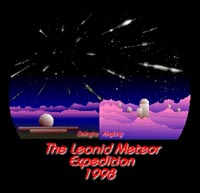GROUND BASED CAMPAIGNS IN CHINA
 The Chinese scientific effort to observe the Leonids is coordinated by
Purple Mountain Observatory in Nanjing (Dr. Li Guangyu). Two ground-based
campaigns for optical imaging and stereoscopic measurements are
organised in collaboration
with the Dutch Meteor Society,
who will contribute equipment, expertise and manpower.
The two sites are at the Qinghai Radio Observatory
near Delingha in a desert in the middle of China, operated by Purple Mountain Observatory,
and at the Xinglong optical station of the Beijing Astronomical Observatory
in the wooded hills near Beijing. Local organisation of the Xinglong Station is
with the Beijing Astronomical Observatory (Dr. Zhu Jin).
This observing campaign provides ground-based
support for the Leonid Multi Instrument Aircraft Campaign for flux measurements
and astrometry.
The Chinese scientific effort to observe the Leonids is coordinated by
Purple Mountain Observatory in Nanjing (Dr. Li Guangyu). Two ground-based
campaigns for optical imaging and stereoscopic measurements are
organised in collaboration
with the Dutch Meteor Society,
who will contribute equipment, expertise and manpower.
The two sites are at the Qinghai Radio Observatory
near Delingha in a desert in the middle of China, operated by Purple Mountain Observatory,
and at the Xinglong optical station of the Beijing Astronomical Observatory
in the wooded hills near Beijing. Local organisation of the Xinglong Station is
with the Beijing Astronomical Observatory (Dr. Zhu Jin).
This observing campaign provides ground-based
support for the Leonid Multi Instrument Aircraft Campaign for flux measurements
and astrometry.
In addition to this optical imaging effort, there are ambitious
plans for using a range of
other techniques at the time of the Leonid storm. Funding is presently sought for:
the use of ionosonde,
high frequency radar, laser radar and long wave guiding equipment to determine
the occurrence probability of meteoroids, anomalous change in density of ionospheric
electrons and sodium ions at 80-120 km altitude.
The use of an infrasonic equipment system to monitor and research the
characteristics of infrasonic wave and its propagation regularity.
For this purpose, several multiple point infrasonic arrays located near Beijing can be
used, as well as the high frequency Skywave radar in HeBei province, the
laser radar of the physical and mathematical Institute of CAS in WuHan
City and all the ionosonde of ionosphere stations.
Also, support is sought to use the
optical GDI tracking theodolites (5 sets), AT wide angle telescopes (27 sets),
NAFA 3C Cameras (2 sets), and Meteoric Cameras (2 sets).
All of these instruments are distributed on 5 artificial satellite
stations in Changchun, Beijing,
Qingdao, Shanghai and Guangzhou, sustaining an arc of more than 20 degree
from north to south. Spots
near Xining and Urumqi in west China can provide optical support to monitor
the Leonid shower activities.
